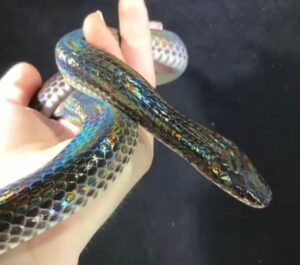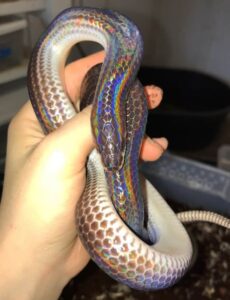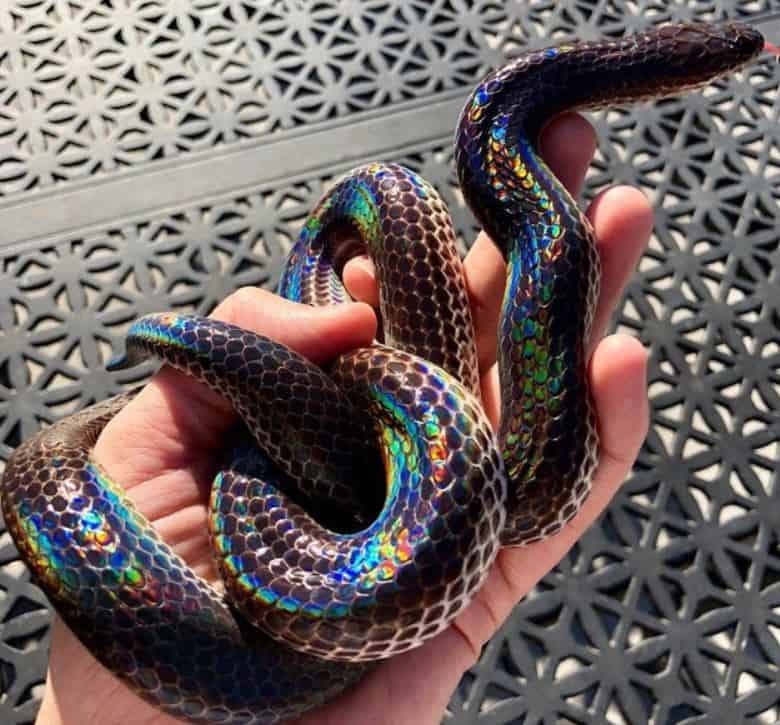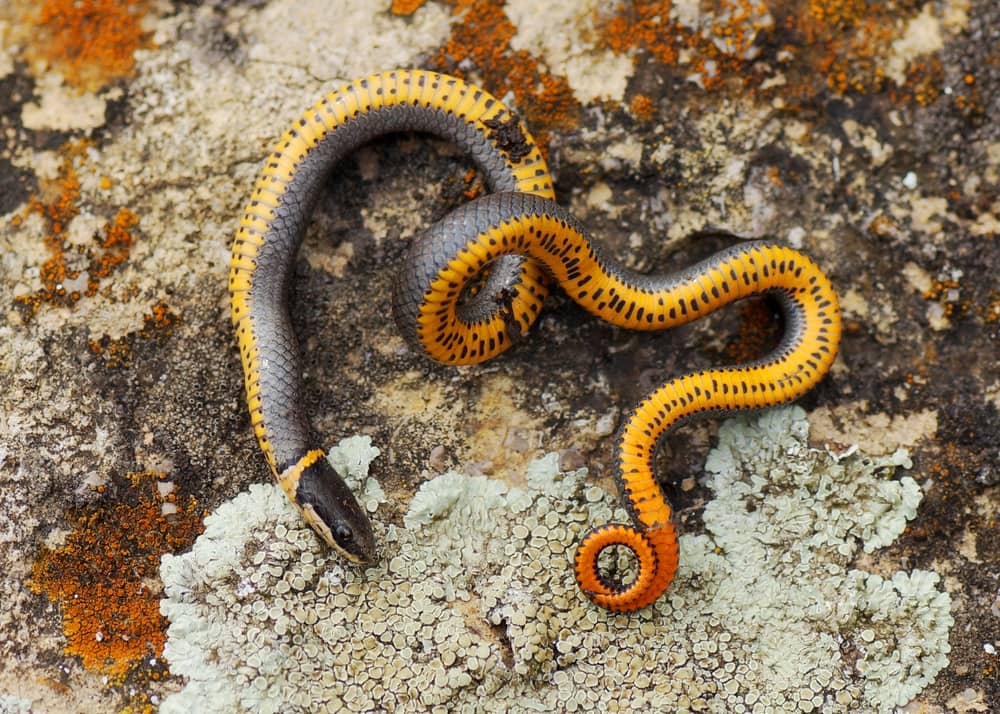Ever seen a snake that shines like a rainbow under the sun? Meet the Sunbeam Snake, a mysterious and beautiful reptile that looks like something out of a fantasy novel. With its glossy, iridescent scales and secretive lifestyle, the Sunbeam Snake is a truly underrated gem in the world of reptiles. Let’s dig into the life and legend of this fascinating serpent.
🔬 Taxonomy and Classification
Scientific Name and Family
The Sunbeam Snake goes by the scientific name Xenopeltis unicolor. It belongs to the family Xenopeltidae, which is quite unique because it contains only this genus. Yes, it’s a bit of a loner in the snake family tree!
Common Names Across Regions
Depending on where you are, people might call it the Shiny Snake, Iridescent Snake, or simply Sunbeam. Its radiant appearance is so striking that its common names almost always reference its shine.
✨ Appearance and Physical Characteristics
Iridescent Scales – Nature’s Living Rainbow
Sunbeam Snakes are best known for their mirror-like scales that reflect sunlight in a stunning rainbow spectrum. It’s like they’re wearing a built-in disco ball suit!
Size, Shape, and Weight
On average, these snakes grow about 3 to 4 feet long, with a smooth, cylindrical body and a blunt head. Their bodies are built for digging, not climbing, so they stay low to the ground.

🌍 Natural Habitat
Native Range and Distribution
You’ll find Sunbeam Snakes slithering through Southeast Asia, particularly in Thailand, Vietnam, Cambodia, and parts of Malaysia. They love moist, warm climates.
Preferred Environments
Their favorite hangouts include rice paddies, forest floors, and muddy fields. They thrive where the soil is soft, moist, and easy to burrow into.
🦎 Behavior and Temperament
Nocturnal and Burrowing Lifestyle
These snakes are shy and secretive. They sleep during the day and come out to hunt at night. You’re more likely to see a Sunbeam Snake during or after a rainstorm, slithering out of the mud.
Interaction with Humans
Despite their eerie beauty, Sunbeam Snakes are non-aggressive and gentle. They rarely bite and are known for their calm demeanor—perfect for those who want a low-drama pet.
🍽️ Diet and Feeding Habits
What Do Sunbeam Snakes Eat in the Wild?
In their natural habitat, Sunbeam Snakes munch on frogs, small reptiles, and earthworms. They’re not picky eaters but prefer prey that’s easy to catch.
Feeding in Captivity
In captivity, they readily eat frozen-thawed rodents, which makes feeding convenient for pet owners. However, they may need some time to adjust to non-live food.

🐣 Reproduction and Life Cycle
Mating Habits
Sunbeam Snakes are oviparous, meaning they lay eggs. Mating usually occurs in the rainy season, when conditions are ideal for laying and hatching.
Egg-laying and Incubation
A female can lay up to 10 eggs at a time, typically hiding them in soft, damp soil. The eggs hatch in about 60–70 days, giving way to adorable, iridescent hatchlings.
🛡️ Adaptations and Survival Mechanisms
How Iridescence Helps in the Wild
Their reflective scales don’t just look pretty—they can confuse predators. When a ray of light hits their body, it creates a flash that can disorient attackers.
Defense Mechanisms
Their go-to defense? Burrowing. If threatened, they’ll vanish into the ground quicker than you can say “snake!” They rarely resort to biting.
🏡 Sunbeam Snake as a Pet
Suitability for Beginners
While their care requirements are specific, they can be a great pet for those who are patient and committed. Their docile nature makes them good for calm handling.
Enclosure Setup and Care Tips
A basic setup includes:
-
A moist substrate like coconut fiber or sphagnum moss
-
Humidity levels around 80%
-
A temperature gradient from 75°F to 85°F
-
A hiding spot and a shallow water dish
Lighting isn’t a huge priority since they’re nocturnal, but humidity is crucial.

💊 Health and Common Issues
Signs of a Healthy Sunbeam Snake
Look for:
-
Smooth, shiny skin
-
Regular feeding behavior
-
No wheezing or gaping
A healthy Sunbeam Snake is active at night and sheds cleanly.
Potential Diseases and Preventive Measures
Keep an eye out for respiratory infections, scale rot, and mites. Regular enclosure cleaning and proper humidity can prevent most issues.
🌱 Conservation Status
Are Sunbeam Snakes Threatened?
Currently, the Sunbeam Snake is listed as Least Concern by the IUCN. However, habitat destruction poses a future threat.
Human Impact on Their Habitat
Urban development and agricultural expansion can limit their burrowing areas. Thankfully, they adapt relatively well to rice fields and semi-urban settings.
🌟 Interesting Facts
Myths and Cultural Beliefs
In some Southeast Asian cultures, Sunbeam Snakes are seen as symbols of good luck or guardians of the earth, due to their underground life.
Unique Traits You Didn’t Know
-
They lack heat-sensing pits, unlike many snakes.
-
They can stay motionless for hours to avoid detection.
-
Their scale structure is unlike any other snake.
🐍 Comparison with Other Snakes
Sunbeam Snake vs. Rainbow Boa
While both have iridescent scales, Rainbow Boas are larger, more aggressive, and arboreal, while Sunbeams are gentle, smaller, and terrestrial.
Sunbeam Snake vs. Garter Snake
Garter Snakes are diurnal and more active, while Sunbeam Snakes are secretive and nocturnal. Garter snakes also lack the mesmerizing shimmer!
📍 Where to See or Buy Sunbeam Snakes
Ethical Breeders and Pet Stores
If you’re looking to own one, always go through ethical breeders who provide captive-bred individuals. Avoid wild-caught snakes whenever possible.
Wildlife Tours and Sanctuaries
Some eco-tours in Thailand and Vietnam may offer a chance to observe Sunbeam Snakes in the wild—just don’t expect them to come out unless it’s raining!
✅ Conclusion
The Sunbeam Snake is truly one of nature’s hidden treasures. With its dazzling looks, gentle nature, and secretive behavior, it offers a magical experience for wildlife lovers and reptile keepers alike. Whether you’re just admiring them from afar or considering one as a pet, there’s no denying the awe they inspire.
❓ FAQs
Q1: Are Sunbeam snakes venomous?
No, Sunbeam Snakes are completely non-venomous and pose no threat to humans.
Q2: How long do Sunbeam snakes live?
In captivity, they can live up to 10–12 years with proper care.
Q3: Can Sunbeam snakes be handled often?
They can be handled gently, but not frequently—they prefer solitude.
Q4: What size tank does a Sunbeam snake need?
A 20 to 30-gallon tank is sufficient for a single adult.
Q5: Do Sunbeam snakes bite?
Rarely. They’re shy and docile, and biting is almost never their first defense.



